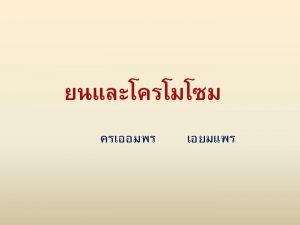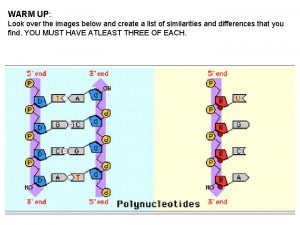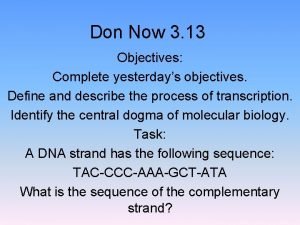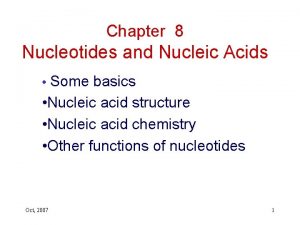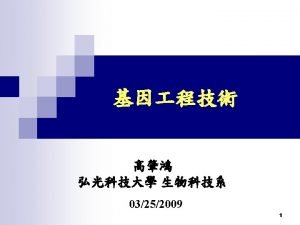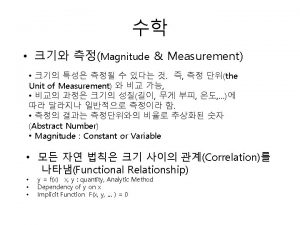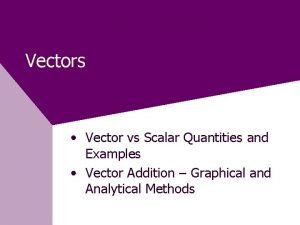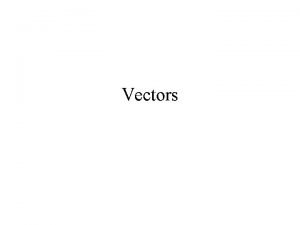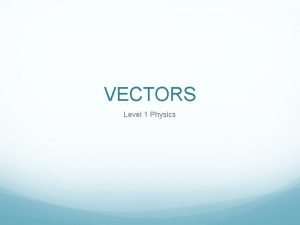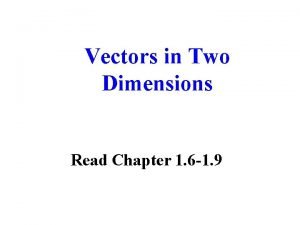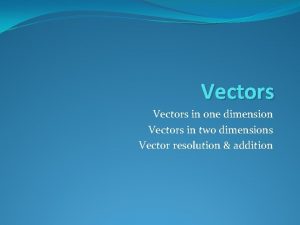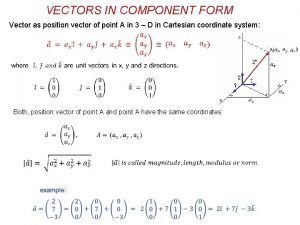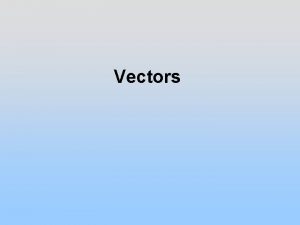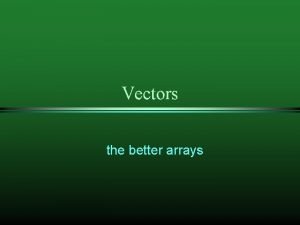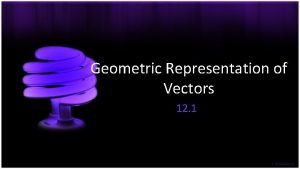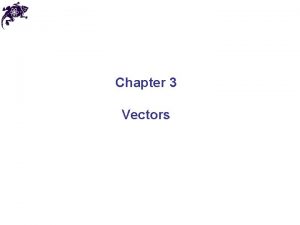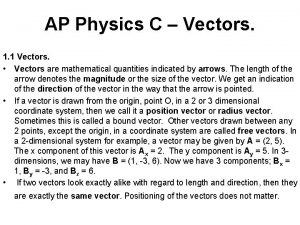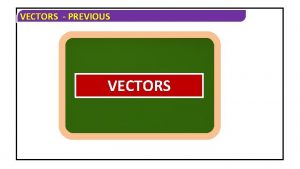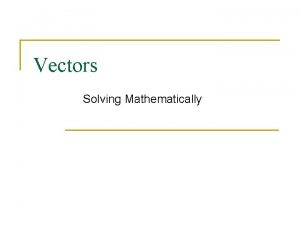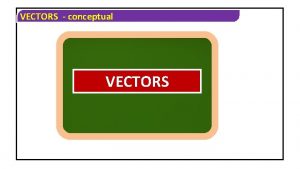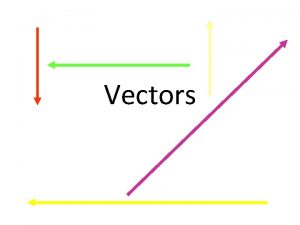Strand J UNIT J 3 Vectors STRAND J

















- Slides: 17

Strand J UNIT J 3: Vectors

STRAND J Unit J 3 Vectors can be used to describe translations. You have two sections to work through and there are check up audits and fitness tests for each section. 1. Vectors and Scalars 2. Vectors and Geometry

STRAND J Unit J 3 Vectors and Scalars Section J 3. 1 Translations can be described using 2 -dimensional vectors. The ‘image’ is the translated object 4 units to the right 2 units up The vector specifies the length (how far) and the direction in which the triangle is to be moved.

STRAND J Unit J 3 Vectors and Scalars Section J 3. 1 As we have just seen, vectors have magnitude (size) and direction. Quantities which have only size are known as scalars or scalar quantities. Examples of vectors are: displacement, force and velocity. Examples of scalars are: mass, length, distance, area and speed. Notation: A vector is written in bold, like a and b, and a scalar quantity is written normally like c. A vector can also be written using the letters if its start and finish with an arrow above, like this: AB a A B

STRAND J Unit J 3 Section J 3. 1 Vectors and Scalars Clear distinctions can be made between: Distance and Displacement Distance is a scalar (like ‘ 5 miles’). Displacement is a vector (‘ 5 miles north-east). You can walk a long way and the distance travelled may be great, but if you return to the start your displacement will be zero! Speed and Velocity Speed is how fast something moves: it is a scalar (like ‘ 5 miles per hour’). Velocity is speed with direction: it is a vector (‘ 5 miles per hour south-west’).

STRAND J Unit J 3 Vectors and Scalars Section J 3. 1 Using vectors: We can add two vectors by joining them together: a b Adding vectors is easy: You simply add together the top numbers And add together the bottom numbers

Vectors and Scalars STRAND J Unit J 3 Section J 3. 1 A similar method is used for subtraction: In general and

STRAND J Unit J 3 Vectors and Scalars Section J 3. 1 Multiplying vectors by scalars is also easy: Each component is simply multiplied by the scalar. In general:

STRAND J Unit J 3 Vectors and Scalars Section J 3. 1 The length of a vector is called its magnitude or modulus: We write this as | a |. a 3 4 =5

STRAND J Unit J 3 Section J 3. 1: Fitness Check Here are some questions to check your progress; there are more practice questions if needed. 1. Which of the following are vectors and which are scalars? a) Time b) Temperature c) Velocity a) 6 c

STRAND J Unit J 3 Section J 3. 1: Review You have completed the first Section. If you have completed and understood this section, click to start the next Section. If you need more examples and interactive practice, go to http: //szalonta. hu/ske/text/J 3/skej 3 s 1. html

STRAND J Unit J 3 Section J 3. 2 Vectors and Geometry Vectors can be used to solve problems in geometry. It is possible to describe any point, in 2 dimensions, using two vectors. For example, using multiples of the vectors a and b, we can get to all the points shown on the diagram, assuming that the AE = EI and AB = BC = CD and lines AI and BJ etc. and AD and EH etc. are parallel. AC EH KJ KG BJ Parallel vectors are those with the same direction; they do not have to be the same size. Examples of parallel vectors are: AE, CK and HL. Note: to reverse the direction of a vector, reverse the sign of the vector

Vectors and Geometry STRAND J Unit J 3 Section J 3. 2 Not drawn to scale Solution: Express in terms of x and y: BA Show that CP DB DP

STRAND J Unit J 3 Vectors and Geometry Section J 3. 2 Not drawn to scale Solution Given that E is the midpoint of DC, prove that A, P and E are collinear. We know: and that is PE and AP have the same direction. DE And AP and PE have point P in common, so A, P and E are collinear (i. e. all lie on a single straight line).

STRAND J Unit J 3 Vectors and Geometry Section J 3. 2 Solution Find, in terms of a, the vector AD Find, in terms of a and b, the vector AB Find, in terms of b, the vector AF (as is parallel to OB) Find, in terms of a and b, the vector FC

Section J 3. 2: Fitness Check STRAND J Unit J 3 Here are some questions to check your progress; there are more practice questions if needed. Section J 3. 2 Write the following vectors in terms of a and c. AB AC CB OB BC CA 2. In the diagram, if X is the midpoint of AB and Y is the midpoint of BC, find the following in terms of a and c. AX OX OY XY

STRAND J Unit J 3 Section J 3. 2: Review Section J 3. 2 You have completed the last Section. If you need more examples and interactive practice, go to http: //szalonta. hu/ske/text/J 3/skej 3 s 2. html
 Dispersive model
Dispersive model Mrna strand that is complementary to the dna strand aattgc
Mrna strand that is complementary to the dna strand aattgc Template strand, new strand, base pair, and dna polymerase.
Template strand, new strand, base pair, and dna polymerase. Watson strand crick strand
Watson strand crick strand Watson strand crick strand
Watson strand crick strand Cartesian to polar unit vectors
Cartesian to polar unit vectors Ixj cross product
Ixj cross product Unit 10, unit 10 review tests, unit 10 general test
Unit 10, unit 10 review tests, unit 10 general test /scriptimg srcx onerroralert1
/scriptimg srcx onerroralert1 Example of vector
Example of vector A vector is a quantity that has
A vector is a quantity that has Collinear vectors example
Collinear vectors example Vectors in 2 dimensions
Vectors in 2 dimensions Vectors in two dimension
Vectors in two dimension How to write component form of a vector
How to write component form of a vector Formula for partitioning a line segment
Formula for partitioning a line segment Decomposing vectors
Decomposing vectors Vectors and scalars in physics
Vectors and scalars in physics
